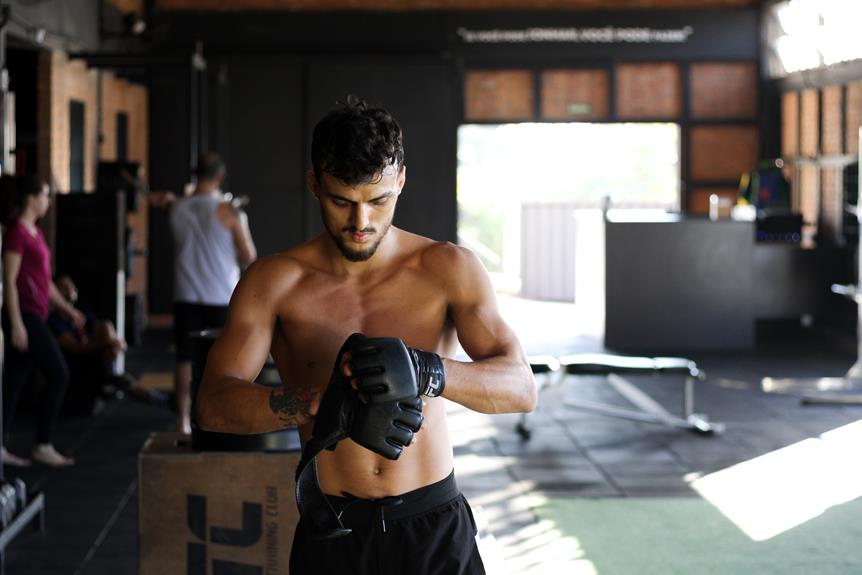In the ever-evolving world of UFC, fighters are the architects of their own destiny, sculpting their bodies and honing their skills to reach the pinnacle of success.
Like a master craftsman, they strive for perfection, seeking the optimal age at which to showcase their prowess in the octagon.
This article delves into the question that has intrigued fight enthusiasts for years: what is the prime age for UFC fighters?
Through insightful analysis and a deep understanding of the sport, we aim to shed light on this captivating topic.
Key Takeaways
- The prime age for UFC fighters has shifted from 25-30 years old to 30-35 years old.
- Fighters in the 30-35 age range are experienced, intelligent, skillful, and physically strong.
- Improved health and safety measures, such as proper rest periods, medical insurance, and training facilities, contribute to fighters being able to compete in their prime.
- Experience is a key factor in the prime age, as younger fighters may lack fight intelligence and decision-making skills.
Factors Influencing Prime Age
Several factors play a significant role in determining the prime age for UFC fighters. One of these factors is fighter longevity, which has improved over the years due to advancements in training methods and better understanding of MMA health and safety.
The evolution of training methods has allowed fighters to optimize their physical condition and skills, enabling them to compete at a high level for a longer period of time. This has shifted the prime age for UFC fighters from the first 20 years of the sport, which was between 25-30, to now being pushed forward to 30-35.
Fighters in this age range possess the experience, intelligence, and skillfulness that comes with years of martial arts training. While there may be a slight decline in certain traits such as speed, the overall physical strength and fight IQ of fighters in this age range make them formidable opponents.
Shift in Prime Age
The shift in the prime age for UFC fighters can be observed in the transition from the first 20 years of the sport, where fighters between the ages of 25-30 were considered at their peak, to the current trend of pushing the prime age forward to 30-35.
This shift can be attributed to several factors, including the impact of evolving training methods and the role of nutrition in extending the prime age. With advancements in sports science and conditioning programs, fighters are now able to train smarter and more efficiently, allowing them to maintain their physical and technical skills well into their thirties.
Additionally, the emphasis on proper nutrition and diet has significantly contributed to the longevity of fighters, enabling them to compete at a high level for a longer period of time.
As the sport continues to evolve, we can expect the prime age for UFC fighters to continue shifting, as athletes optimize their training and nutrition strategies to maximize their performance.
Improved Health and Safety Measures
With advancements in sports science and conditioning programs, fighters are now able to train smarter and more efficiently, allowing them to maintain their physical and technical skills well into their thirties, thereby significantly improving the health and safety measures for UFC fighters. These improvements have led to a decrease in the number of injuries and a higher level of injury prevention among UFC fighters.
Here are two key factors contributing to the improved health and safety measures:
- UFC fighter injury prevention:
- Implementation of proper training techniques and strategies to minimize the risk of injuries during fights.
- Regular assessments and screenings to identify potential areas of weakness or vulnerability and address them proactively.
- Impact of medical suspensions:
- Medical suspensions are imposed by athletic commissions to allow fighters sufficient time to recover from injuries sustained during fights.
- This ensures that fighters are physically and mentally fit to compete again, reducing the chances of further injury and long-term health issues.
These measures have created a safer environment for UFC fighters, allowing them to perform at their best while minimizing the risk of serious injuries.
Experience as the Key Factor
Experience plays a crucial role in determining the prime age for UFC fighters, as it provides them with the fight intelligence and decision-making skills necessary to compete against top fighters in the increasingly competitive world of MMA. The importance of fight IQ in UFC fighters cannot be overstated. It is through years of experience inside the octagon that fighters learn to read their opponents, anticipate their moves, and strategically respond.
Experience also has a significant impact on decision-making in the octagon. Seasoned fighters have been in various situations, allowing them to make split-second decisions with composure and accuracy. Younger fighters may possess talent and athleticism, but without the experience, they often fall short against older, more experienced fighters who have honed their skills over time.
Therefore, experience is a key factor in determining the prime age for UFC fighters, as it contributes to their fight intelligence and decision-making abilities.
Supporting Metrics for Prime Age
Supporting the importance of experience as a key factor in determining the prime age for UFC fighters, various metrics provide evidence of the optimal age range for success in the octagon.
- UFC Prime Age: Factors, Trends, and Metrics:
- *Average Age of Current UFC Champions:* The average age of current UFC champions is 33, indicating that fighters in their early thirties tend to dominate the sport.
- *Age When Champions First Won a UFC Title:* On average, current champions won their first UFC title at the age of 29.6, highlighting the significance of experience and skill development over time.
These metrics reinforce the notion that the prime age for UFC fighters falls within the range of 30-35 years old. This aligns with recent trends in the sport, where fighters in this age range have demonstrated a combination of experience, intelligence, skill, and physical strength that propels them to the top of their divisions.
While exceptions like Jon Jones exist, the overall data indicates that the prime age for success in the UFC remains consistent.
Advantage of Fight Experience
Fight experience provides a significant advantage for UFC fighters, allowing them to develop crucial skills and decision-making abilities in the octagon. The impact of fight experience on performance cannot be overstated. As fighters accumulate more fights under their belt, they become more familiar with different styles, techniques, and strategies. This experience helps them anticipate their opponents' moves, react quickly, and make better decisions during the fight.
The advantages of fight experience can be summarized in the following table:
| Advantages of Fight Experience | Impact on Performance |
|---|---|
| Enhanced fight intelligence | Improved situational awareness and adaptability |
| Sharpened technical skills | More effective striking and grappling techniques |
| Increased mental toughness | Better resilience and ability to handle pressure |
| Refined fight strategy | Enhanced ability to analyze and exploit opponents' weaknesses |
With each fight, fighters gain valuable knowledge and insights that cannot be taught in training alone. This accumulated experience gives them a competitive edge over younger, less experienced opponents. It is no wonder that fighters in their prime age range of 30-35 often dominate the UFC, showcasing the benefits of their fight experience.
Peak Physical Condition
One crucial aspect that significantly influences the prime age of UFC fighters is their physical condition. Fighters in their prime possess peak physical condition, which is achieved through a combination of effective training methods and injury prevention strategies.
Training methods:
- Fighters engage in rigorous training programs that focus on enhancing their strength, speed, agility, and endurance.
- They incorporate various martial arts disciplines, such as Brazilian Jiu-Jitsu, Muay Thai, and wrestling, to develop a well-rounded skillset.
Injury prevention:
- Fighters prioritize injury prevention to ensure they can compete at the highest level for an extended period.
- They employ techniques such as proper warm-up and cool-down routines, regular stretching, and targeted strength and conditioning exercises.
- They also work closely with medical professionals to address any existing injuries and receive appropriate treatment.
Improved MMA Health and Safety
Improved MMA health and safety measures have significantly contributed to the well-being and longevity of UFC fighters. These measures have had a positive impact on fighter longevity by reducing the risk of serious injuries and promoting overall fighter well-being. One key factor in improving fighter health and safety is the role of coaching and training. Coaches play a crucial role in ensuring that fighters are properly prepared for fights and are following safe training practices. Training facilities, such as the UFC Performance Institute, provide fighters with access to state-of-the-art equipment and resources to optimize their training and recovery. Additionally, the implementation of proper rest periods between fights, medical insurance coverage for training-related injuries, and the publication of comprehensive studies on performance and safety have all contributed to the improved health and safety of UFC fighters.
| Improved MMA Health and Safety Measures |
|---|
| Proper rest periods between fights |
| Medical insurance coverage for training-related injuries |
| Peak training and recovery facilities like the UFC Performance Institute |
| Better pay allows fighters to enter fights in peak condition and afford the best coaching |
| UFC published a comprehensive study on performance, recovery, safety, and brain injury |
Decline in Traits and Becoming a Champion
The decline in certain traits, coupled with the pursuit of becoming a champion, is a critical aspect to consider when examining the prime age for UFC fighters. As fighters age, they may experience a decline in physical attributes such as speed and agility, which can affect their performance inside the octagon.
However, it is important to note that the definition of a champion goes beyond physical prowess. Becoming a champion requires a combination of skills, experience, fight IQ, and mental fortitude. It is the ability to adapt to different opponents, strategize effectively, and perform under pressure that sets champions apart.
While physical decline is inevitable, fighters who possess the necessary traits and continue to evolve can still achieve greatness and reach the pinnacle of the sport.
Frequently Asked Questions
How Has the Ufc's Focus on Improved Health and Safety Measures Affected the Prime Age of Fighters?
The UFC's focus on improved health and safety measures has had a significant impact on the prime age of fighters. By reducing injury rates, fighters can compete for longer, pushing the prime age forward to 30-35. This allows for more experienced and skillful fighters to thrive in the sport. Additionally, the evolution of training techniques has enabled fighters to reach their peak physical condition and perform at their best.
Are There Any Notable Exceptions to the Shift in Prime Age for UFC Fighters?
Notable exceptions to the shift in prime age for UFC fighters can be seen in fighters like Jon Jones, who won a title at 23. However, the impact of training methods and experience still make the 30-35 age range crucial for success.
What Factors Contribute to a Fighter's Experience and Fight Intelligence?
Fighters' experience and fight intelligence are shaped by factors such as physical conditioning and mental toughness. These attributes develop over time through rigorous training, exposure to different opponents, and the ability to make strategic decisions in high-pressure situations.
How Do the Average Ages of Current UFC Champions Compare to the Average Ages of Top 15 Fighters in Each Weight Class Division?
The average age of current UFC champions is 33, while the average age of top 15 fighters in each weight class division ranges from 30 to 32. These metrics support the prime age range of 30-35 for UFC fighters.
What Role Does Talent Play in a Fighter's Prime Age, and How Does It Compare to Experience?
Talent is important, but experience is the key factor in a fighter's prime age. Improved health and safety measures have pushed the prime age for UFC fighters to 30-35, where fighters are experienced, skillful, and physically strong.
Conclusion
In conclusion, the prime age for UFC fighters has shifted from the traditional 25-30 range to a new window of 30-35. This change can be attributed to various factors, including improved health and safety measures, the importance of experience over raw talent, and the advantage of fight experience.
By analyzing supporting metrics and trends, it becomes clear that age and experience play significant roles in a fighter's performance in the octagon. So, next time you see a seasoned fighter in their 30s, remember that age is just a number in the world of UFC.
- 15 Best Martial Arts Weapons (Fighting & Training) - October 14, 2024
- Is Fencing a Martial Art? (Yes, 4 Reasons Why) - October 14, 2024
- 7 Best Martial Arts for Self-defense Ranked (Highly Effective) - October 14, 2024










